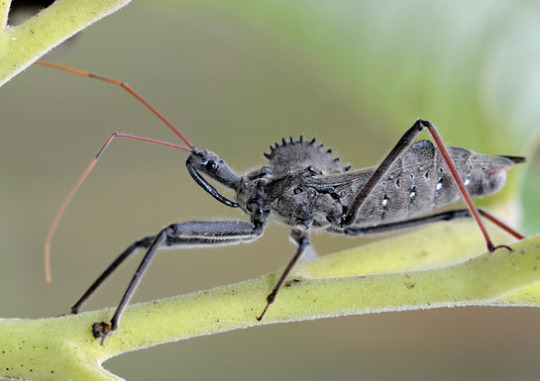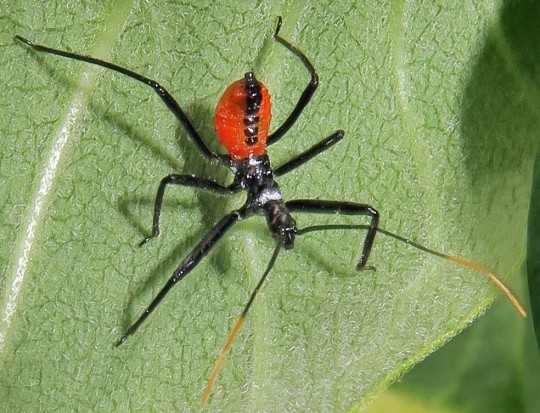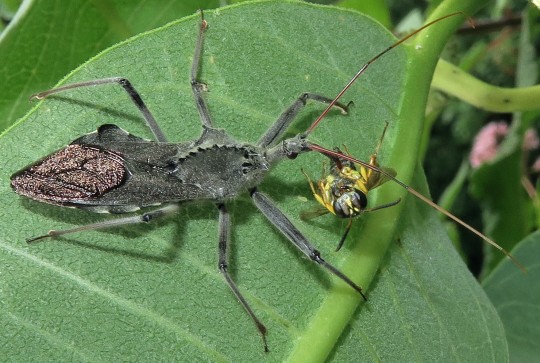As March was approaching, I knew I was ‘on deck’ to produce a blog entry originating from our Section of Invertebrate Zoology. Looking at the calendar, I saw that the deadline would land around the 15th of the month, and something nagged at me about that date – what was the significance? Why, yes – the Ides of March was looming! Shakespeare’s Caesar failed to heed the warnings, and in the end… met his assassin…
So, let’s take a look at an insect that carries the moniker of “assassin bug” – a species that possesses a bite of which everyone should truly beware. The insect is Arilus cristatus (Linnaeus), a species of ‘true bug’ in the order Heteroptera, in the family Reduviidae, collectively known as the assassin bugs. Arilus cristatus also carries the common name of ‘wheel bug’ due to the distinctive, serrated crest on its pronotum that in profile resembles a portion of a wheel or gear. No other insect in the United States possesses such a structure and the ‘wheel’ allows this species to be readily identified. In addition to the odd cog-like crest, the bug is large – nearly 1 ½ inches in length in mature adults and is dull gray in coloration. The immatures, or nymphs, look entirely different – they are small, bright red and lack the ‘wheel.’

The wheel bug occurs throughout the southern half of the United States, ranging northward to the upper Midwest and southern New England. While Southwest Pennsylvania is within its natural distributional range, it appears to have become more common in our area over the last decade. People began bringing specimens into the museum for identification at an increasing rate starting around 10 or so years ago. While the evidence is anecdotal, the apparent increase in their abundance in our area could be a result of our changing climate – as our region becomes warmer on average, the environment becomes more suitable for the wheel bug, allowing it to thrive. Another potential factor for its increased numbers in our area is the introduction of an invasive species, the brown marmorated stinkbug, Halyomorpha halys Stål — a true bug species native to eastern Asia. With an increase in easily captured prey, the wheel bug may be exploiting this new food source. On a number of occasions, I have witnessed wheel bugs feeding on the introduced stinkbugs in the field.

All of the reduviids are predatory on other invertebrates, using their beak-like mouthparts to pierce their prey and inject a powerful mix of enzymes that kills and begins digesting their prey from the inside, similar to the feeding habits of spiders. I can attest, from personal experience, to the extreme pain this insect can inflict by its bite. Wheel bugs, like many Insects, can be attracted to lights at night, and while collecting around some bright gas station lights some years ago, I foolishly decided to pick one up by the wheel with my bare fingers, assuming it could not reach me with its relatively short beak – and oh, how wrong I was! The initial bite was not terribly bad, but unusual, feeling like a tiny electrical shock. In less than a minute, however, a sharp, burning sensation began spreading the length of my thumb. The pain reached a crescendo in about 5 minutes and stayed at that level for several hours. The next day, the burning had subsided, but was replaced by a dull, throbbing ache that felt as if I’d smashed my thumb with a hammer. That discomfort persisted for a couple more days, yet oddly, there was no swelling and no obvious redness or sore at the site of the bite.

While the bite of the wheel bug can certainly be a painful experience, and potentially worse in individuals that have a sensitivity or allergic reaction to the bite, they are rightfully considered a beneficial insect. Their predatory behavior helps rid gardens and forests of a wide variety of pest insects, from leaf-feeding beetles to caterpillars — a process of natural pest elimination known as biocontrol. So, if you should encounter a wheel bug — mid- to late summer is their peak time of activity — enjoy observing this odd insect and appreciate it for the role it plays in the environment. But heed my warning — resist any temptation to pick it up for a closer look!
Bob Androw is a Scientific Preparator in Invertebrate Zoology. Museum employees are encouraged to blog about their unique experiences and knowledge gained from working at the museum.
